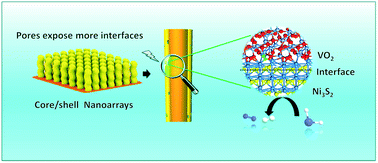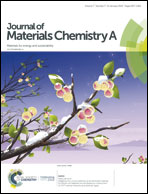One-step construction of core/shell nanoarrays with a holey shell and exposed interfaces for overall water splitting†
Abstract
Developing earth-abundant highly efficient water-splitting electrocatalysts has become of great importance for sustainable energy conversion processes. Herein, we construct a unique Ni foam-supported Ni3S2/VO2 core/shell nanoarray (CSN) with exposed interfaces via facile one-step growth of a holey ultrathin VO2 shell on Ni3S2 1D nanowires for highly efficient water splitting. Systematic experiments and density functional theory calculations reveal that interfaces in situ generated between the Ni3S2 core and the VO2 shell possess a low energy level d band center and less Gibbs free energy of reaction intermediates and further act as catalytic sites with enhanced intrinsic activity. Moreover, their 1D morphology, the holey shell, and the conductive substrate are beneficial for enhanced surface area and interfaces, efficient charge and mass transfer, good conductivity and structural stability. The obtained Ni3S2/VO2 CSN exhibited extremely high electrocatalytic activity and excellent durability towards electrocatalysis for the OER, HER and overall water splitting. Indeed, it requires only a very low cell voltage of 1.42, 1.45 and 1.65 V to afford current densities of 10, 20 and 100 mA cm−2, respectively, in alkaline electrolyzers, serving as one of the best water-splitting electrocatalysts to date. This work not only presents deeper understanding of intrinsic electrocatalytic properties of heterostructured catalysts with exposed interfaces but also opens new opportunities for better design of advanced electrocatalysts for water splitting.



 Please wait while we load your content...
Please wait while we load your content...